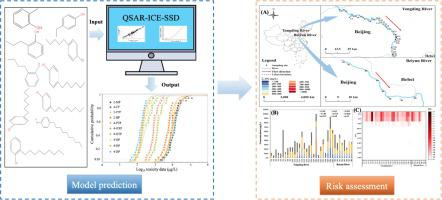Environment International ( IF 11.8 ) Pub Date : 2022-06-21 , DOI: 10.1016/j.envint.2022.107367 Yajun Hong 1 , Chenglian Feng 2 , Xiaowei Jin 3 , Huiyu Xie 2 , Na Liu 2 , Yingchen Bai 2 , Fengchang Wu 2 , Sandy Raimondo 4

|
Alkylphenols (APs) are ubiquitous and generally present in higher residue levels in the environment. The present work focuses on the development of a set of in silico models to predict the aquatic toxicity of APs with incomplete/unknown toxicity data in aquatic environments. To achieve this, a QSAR-ICE-SSD model was constructed for aquatic organisms by combining quantitative structure–activity relationship (QSAR), interspecies correlation estimation (ICE), and species sensitivity distribution (SSD) models in order to obtain the hazardous concentrations (HCs) of selected APs. The research indicated that the keywords “alkylphenol” and “nonylphenol” were most commonly studied. The selected ICE models were robust (R2: 0.70–0.99; p-value < 0.01). All models had a high reliability cross- validation success rates (>75%), and the HC5 predicted with the QSAR-ICE-SSD model was 2-fold than that derived with measured experimental data. The HC5 values demonstrated nearly linear decreasing trend from 2-MP to 4-HTP, while the decreasing trend from 4-HTP to 4-DP became shallower, indicates that the toxicity of APs to aquatic organisms increases with the addition of alkyl carbon chain lengths. The ecological risks assessment (ERA) of APs revealed that aquatic organisms were at risk from exposure to 4-NP at most river stations (the highest risk quotient (RQ) = 1.51), with the highest relative risk associated with 2.9% of 4-NP detected in 82.9% of the sampling sites. The targeted APs posed potential ecological risks in the Yongding and Beiyun River according to the mixture ERA. The potential application of QSAR-ICE-SSD models could satisfy the immediate needs for HC5 derivations without the need for additional in vivo testing.
中文翻译:

烷基酚物质PNEC的QSAR-ICE-SSD模型预测及其在特大城市河流生态风险评估中的应用
烷基酚 (AP) 无处不在,并且通常在环境中以较高的残留量存在。目前的工作重点是开发一套计算机模型来预测水生环境中毒性数据不完整/未知的 AP 的水生毒性。为了实现这一目标,通过结合定量结构-活性关系(QSAR)、种间相关估计(ICE)和物种敏感性分布(SSD)模型,构建了水生生物的QSAR-ICE-SSD模型,以获得有害浓度(选定 AP 的 HC)。研究表明,“烷基酚”和“壬基酚”是最常被研究的关键词。所选的 ICE 模型稳健(R 2:0.70–0.99;p 值 < 0.01)。所有模型都具有高可靠性的交叉验证成功率(>75%),并且使用QSAR-ICE-SSD模型预测的HC 5是使用实测实验数据得出的HC 5 的2倍。HC 5值从2-MP到4-HTP呈现近线性下降趋势,而从4-HTP到4-DP下降趋势变浅,表明APs对水生生物的毒性随着烷基碳链的添加而增加长度。受影响者的生态风险评估(ERA)显示,大多数河流站的水生生物都面临暴露于 4-NP 的风险(最高风险商(RQ) = 1.51),最高相对风险与 2.9% 的 4-NP 相关。 82.9%的采样点检出NP。根据混合物ERA,目标污染物对永定河和北云河构成了潜在的生态风险。QSAR-ICE-SSD 模型的潜在应用可以满足 HC 5推导的直接需求,而无需额外的体内测试。



























 京公网安备 11010802027423号
京公网安备 11010802027423号